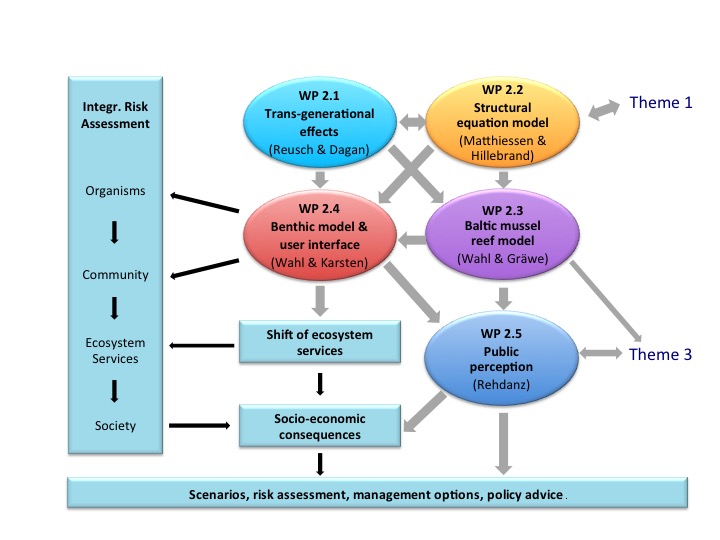BIOACID III – Theme 2: Shifts in Benthic Ecosystems and their Services
The challenge for Theme 2 will be to feed the complex results into synthesising models to adequately exploit the newly achieved insights. The prime objectives of BIOACID III with regard to benthic ecosystems are the following:
- collecting and archiving all available data from the core experiments in BIOACID II but also from other BIOACID consortia and from published literature
- evaluating the potential for adaptation to environmental stress (also in an effort to compensate the inherent weakness of temporally restricted experiments)
- developing three different and complementary models with primarily descriptive but also some predictive intention
- developing a user interface allowing laymen to explore the impact of different aspects of global change on benthic communities
- assessing the awareness and responsiveness of the public to different ways of communicating the new information on global change impact and in particular ocean acidification
Research approaches
During a synthesis phase, we plan to pursue five parallel research lanes which complementarily and in close cooperation will deliver the essential pieces of the final picture.
The capacity of species (and, ultimately, communities) to adapt to a shifting environment will be evaluated based on an extensive meta-analysis of the rapidly growing body of literature. This capacity will help evaluating the trans-generation stress-sensitivity of a species.
Another potential buffering (or amplification) mechanism of stress is the associated shift in biotic interactions. In order to correctly weigh the importance of observed shift it is mandatory to have knowledge how much indirect and direct interactions contribute to the structuring and functioning of a community. This evaluation will be done using Structural Equation Modelling.
In an effort to project some of our findings onto a larger spatial scale, the interaction between climate change, Baltic hydrology and oceanography as well as the sensitivity and distribution of the ecologically and economically important bivalve Mytilus edulis will be modelled.
The multitude of data obtained from the series of core experiments in the Kiel Benthocosms will be used to assemble a new benthic model describing the drivers, interdependencies and responses of benthic communities under environmental pressure. The model is intended to describe the stress impacts at the organism to community level and to facilitate an evaluation of shifts in ecosystem services to be expected. The algorithms of the model will be incorporated into an interactive digital user interface.
A major challenge of global change impact research is to transport the new insights into public awareness. Ways to improve the “transport” of scientific insights into public awareness to increase societal acceptance for adaptation to ongoing environmental shifts shall be explored. We further expect that we will be able to extrapolate from shifts in ecosystem services to the socio-economic consequences of global change and provide valuable advice for managers and decision makers.

Work packages and Structure of Theme 2